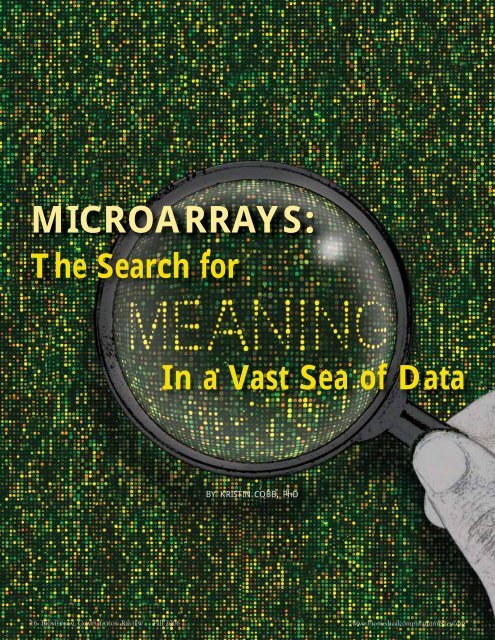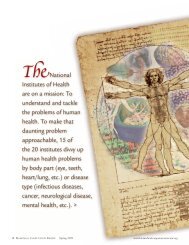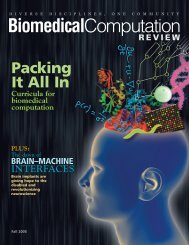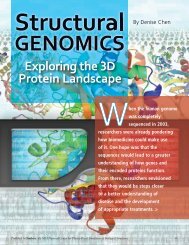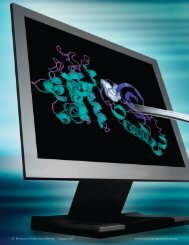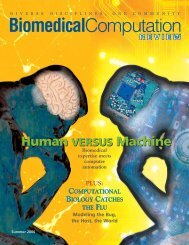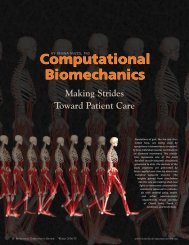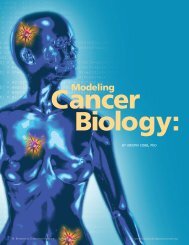MICROARRAYS: - Biomedical Computation Review
MICROARRAYS: - Biomedical Computation Review
MICROARRAYS: - Biomedical Computation Review
You also want an ePaper? Increase the reach of your titles
YUMPU automatically turns print PDFs into web optimized ePapers that Google loves.
<strong>MICROARRAYS</strong>:<br />
The Search for<br />
In a Vast Sea of Data<br />
BY KRISTIN COBB, PhD<br />
16 BIOMEDICAL COMPUTATION REVIEW Fall 2006 www.biomedicalcomputationreview.org
When DNA microarray technology emerged<br />
more than a decade ago, it was met with unbridled<br />
enthusiasm. By allowing scientists to look at<br />
the expression of enormous numbers of genes in<br />
the genome at once, microarrays promised to revolutionize<br />
our understanding of complex diseases and<br />
usher in an era of personalized medicine. Advocates<br />
vowed that, someday, with just a finger prick, doctors<br />
would instantly know whether patients were having<br />
a heart attack, rejecting a transplant, or in the early<br />
stages of cancer based on their mRNA patterns, and<br />
would tailor treatment accordingly.<br />
In the decade since their introduction, microarrays<br />
have permeated virtually all corners of biomedical<br />
research; have yielded some useful insights<br />
into basic biology and cancer; and are being used,<br />
in a preliminary way, to diagnose disease, guide<br />
treatment, and streamline drug discovery. But<br />
early enthusiasm has been tempered with a dose<br />
of reality. Progress has been slower than predicted.<br />
And some splashy results in high-profile journals<br />
have proven difficult to reproduce, casting a shadow<br />
over the real successes.<br />
The shift in perception is palpable in the literature:<br />
a 1999 Nature Genetics article was entitled “Array of<br />
hope,” but a 2005 Nature <strong>Review</strong>s article was entitled<br />
“An array of problems.” 1,2 One recent paper called<br />
microarray studies a “methodological wasteland.” 3<br />
www.biomedicalcomputationreview.org<br />
Fall 2006 BIOMEDICAL COMPUTATION REVIEW 17
All new technologies have growing<br />
pains, and early glitches with the technology<br />
itself are partly to blame. But the bigger<br />
problem is more fundamental. The<br />
huge promise of microarrays is that they<br />
give information about every gene, but<br />
this is also their huge curse—a crushing<br />
onslaught of data. A decade ago, these<br />
data were a mismatch with existing statistical<br />
tools. Today, there is still no consensus<br />
on how to analyze and interpret<br />
them. A 2005 survey of microarray users<br />
concluded that, “Data interpretation and<br />
bioinformatics remain the major hurdles<br />
in microarray technology.” 4<br />
EXPONENTIAL ADVANCE<br />
Microarrays capture a snapshot of<br />
which genes are turned on—or<br />
expressed—in a given cell at a given time.<br />
Before 1995, scientists could<br />
only explore the activity of a few<br />
genes at a time. Then two groups<br />
of researchers—at Stanford<br />
University (led by Patrick<br />
Brown, MD, PhD) and at<br />
Affymetrix—scaled this up thousands-fold<br />
with the invention of<br />
the microarray. The Stanford<br />
microarray is a glass slide coated<br />
with a grid of thousands of<br />
microscopic spots—each corresponding<br />
to a gene—that light up<br />
to show which genes are on,<br />
which are off, and to what<br />
degree they are being expressed.<br />
“At the time it just blew away<br />
the next best thing that you<br />
could do. It was really a quantum<br />
leap ahead,” says Todd<br />
Golub, MD, director of the<br />
Cancer Program at the Broad<br />
Institute of Harvard and MIT.<br />
Besides expression microarrays,<br />
genotyping microarrays<br />
are becoming increasingly popular—these<br />
reveal variation in<br />
the DNA code rather than in<br />
gene activity. Scientists are also<br />
working on microarrays that<br />
use antibodies to detect proteins,<br />
but these have even more<br />
technical challenges.<br />
ARRAY OF HOPE<br />
Microarrays are ideally suited<br />
to study cancer, a disease of<br />
multiple genetic mishaps. They may<br />
also yield improved tests for diagnosis<br />
and prognosis.<br />
In a 1999 paper in Science, Golub<br />
automatically and accurately classified<br />
leukemia patients into the two main subtypes<br />
of the disease using only gene<br />
expression patterns. 5 Though these two<br />
forms of leukemia were already well recognized<br />
and characterized, in principle<br />
this strategy could uncover previously<br />
unknown subtypes of cancer.<br />
Indeed, in a 2001 Proceedings of the<br />
National Academy of Sciences (PNAS)<br />
paper, researchers identified five<br />
unique gene expression patterns in<br />
breast cancer and showed that these<br />
subtypes were five distinct diseases with<br />
different risks of progression. 6<br />
“This surprised the lab scientists.<br />
They said, ‘Wow, look at this—breast<br />
cancer isn’t really breast cancer, it’s<br />
many types of breast cancer,’” says<br />
Gilbert Chu, MD, PhD, professor of<br />
medicine and biochemistry at Stanford.<br />
“But if you talk to anyone who’s been a<br />
clinician for many years, they already<br />
knew this. They’ve seen breast cancers<br />
that looked the same but in some cases<br />
vanished with chemotherapy and in others<br />
did not. So it’s not a surprise that the<br />
gene expression profiles are proving that<br />
these cancers are different.”<br />
A natural extension of this work is to<br />
isolate the particular genes and expression<br />
patterns that are linked to prognosis.<br />
For example, Golub derived a 13-<br />
gene expression signature that correlated<br />
with survival in lymphoma patients; several<br />
other groups have isolated gene sig-<br />
Above: This schematic portrays an experiment using a spotted or cDNA microarray, which consists<br />
of a grid of thousands of microscopic spots on a glass slide; each spot contains cDNA probes for<br />
a gene. Here, researchers extract mRNA (made when genes are active) from two types of cells—<br />
e.g., tumor cells and control cells—and then label the samples with different fluorescent dyes.<br />
When washed over the microarray, these colored transcripts bind to their complementary probes,<br />
leaving a trail of informative spots: red for genes turned on in cancer cells, green for genes turned<br />
on in normal cells, yellow for genes turned on in both types of cells—with more intense color indicating<br />
higher gene activity. Courtesy of The Science Creative Quarterly, artist: Jiang Long.<br />
18 BIOMEDICAL COMPUTATION REVIEW Fall 2006 www.biomedicalcomputationreview.org
natures for breast cancer prognosis.<br />
These signatures can be used in prognostic<br />
tests that gauge if a tumor should<br />
be treated aggressively.<br />
Prognostic genes may also point to<br />
novel drug targets. For example, in a<br />
of molecular and experimental medicine<br />
at the Scripps Institute in San<br />
Diego is working on developing a<br />
microarray-based test to quickly tell him<br />
if a kidney transplant patient is in acute<br />
rejection, chronic rejection, or good<br />
The huge promise of microarrays is that they give information about<br />
every gene, but this is also their huge curse—a crushing onslaught of data.<br />
recent paper in the Journal of Clinical<br />
Oncology, Elaina Collie-Duguid, PhD,<br />
research fellow at the University of<br />
Aberdeen in Scotland, identified one<br />
gene that had a 50-fold higher expression<br />
in lung cancers that were not<br />
responsive to chemotherapy compared<br />
with those that were responsive. 7<br />
The<br />
gene codes for a protein that prevents<br />
tumor cell death; blocking this protein<br />
might boost chemotherapy response.<br />
Microarrays may also help tailor a<br />
treatment to the person, not just the disease,<br />
Chu says. He has identified preliminary<br />
gene signatures in the healthy<br />
cells of cancer patients that predict<br />
which patients will suffer serious side<br />
effects from radiation therapy.<br />
In addition to oncology, microarrays<br />
are also being widely applied in heart<br />
disease and transplant research. Daniel<br />
R. Salomon, MD, associate professor<br />
condition. And he envisions an even<br />
more sophisticated personalized medicine<br />
scenario: “What we ultimately<br />
want is where the doctor says to these<br />
patients, ‘I saw you on Thursday and<br />
you’re doing well but your gene expression<br />
analysis tells me you need more<br />
immunosuppression, so I’m increasing<br />
your dose. Come back and see me in<br />
four weeks and we’ll draw blood and<br />
check your immunosuppression again.’”<br />
Microarrays are also critical in basic<br />
biological research that may ultimately<br />
have a clinical payoff. For example, by<br />
mapping the precise genetic program of<br />
embryonic development, Wing Hung<br />
Wong, PhD, professor of statistics and<br />
Left: The oligonucleotide array (such as the GeneChip from Affymetrix) uses probes that are short strands of DNA synthesized directly on<br />
the chip, and a single type of cell is examined at a time. Courtesy of The Science Creative Quarterly, artist: Jiang Long. Right: InkJet Array.<br />
Agilent Technologies, Inc. uses inkjet printing technology to synthesize oligonucleotide probes on a chip. Courtesy of Agilent.<br />
www.biomedicalcomputationreview.org<br />
Fall 2006 BIOMEDICAL COMPUTATION REVIEW 19
of health research and policy at<br />
Stanford, may be drawing a blueprint for<br />
where and when to deliver genes for<br />
gene therapy.<br />
ARRAY OF PROBLEMS<br />
The initial successes in microarrays<br />
and their exhilarating promise set off a<br />
dizzying flood of microarray studies:<br />
fewer than 100 publications in 1999<br />
“The statistics and how you<br />
analyze the data are still a<br />
quagmire,” says Greg Engel.<br />
grew to more than 6000 in 2004.<br />
Suddenly investigators were identifying a<br />
molecular signature for every disease.<br />
But many publications have since<br />
been discredited or have simply fizzled<br />
out. Scientists say it’s hard to find studies<br />
that have led to anything concrete.<br />
“The thing that’s surprising to me is<br />
that it’s taking so long to figure out<br />
whether and when the technologies<br />
work, and it’s taking so long in the face of<br />
such enormous enthusiasm,” says David<br />
Ransohoff, MD, professor of medicine<br />
and epidemiology at the University of<br />
North Carolina, Chapel Hill.<br />
Of the many factors at work—including<br />
initial snags with the technology—<br />
scientists consistently point to data<br />
analysis and interpretation as the critical<br />
stumbling block.<br />
“For the part of running the experiment,<br />
microarrays seem to be working<br />
pretty well,” says Stanford cardiologist<br />
and medical fellow Greg Engel, MD.<br />
“The informatics part is a whole other<br />
area. The statistics and how you analyze<br />
the data are still a quagmire.”<br />
“I think the greatest challenge at this<br />
time remains data interpretation,”<br />
Golub agrees.<br />
When the data amounted to whether<br />
a single gene was on or off, biologists<br />
had little need for statisticians. But finding<br />
patterns in the activity of 36,000<br />
genes is fundamentally a statistical problem.<br />
When microarrays were introduced,<br />
even the statisticians were<br />
stumped. Existing statistical tools were<br />
built to analyze data on a few variables<br />
measured on many samples. In microarrays,<br />
the situation is reversed: tens of<br />
thousands of genes are measured on just<br />
a few samples—a phenomenon statisticians<br />
are dubbing “p bigger than N” (p<br />
features on N samples).<br />
To illustrate the difficulty, imagine<br />
that you randomly divide 50 people<br />
into two groups and start endlessly<br />
measuring their characteristics:<br />
age, hair color, favorite food,<br />
height, weight, and so forth.<br />
Eventually, you will find characteristics<br />
that are slightly<br />
imbalanced between the two<br />
groups just by chance. And the<br />
more variables you consider,<br />
the more differences you will<br />
find. But the pattern of characteristics<br />
that separates the two groups is an idiosyncrasy<br />
of the sample and has no larger<br />
meaning. The same thing happens<br />
when you compare 36,000 genes<br />
between two sets of 25 cellular samples—<br />
some differences in expression may<br />
reflect real biological changes, but many<br />
more will be false positives.<br />
“The problem here is a deeply profound<br />
statistical one,” Chu says. “The<br />
very nature of microarrays is that they<br />
give you tons of data, and very unusual<br />
patterns can emerge that are not<br />
anything more than noise and statistical<br />
fluctuation.”<br />
As Engel describes it, “What we’re all<br />
doing is we’re taking a statistical<br />
approach and we’re all trying it every<br />
which way. And you’ll even get a pattern.<br />
But is that pattern real? That’s the major<br />
issue for gene chips—is it real?”<br />
Subtle statistical mistakes lead you to<br />
find patterns and get published in highprofile<br />
journals, Chu says. And it may<br />
take years and several expensive followup<br />
studies for anyone to realize that the<br />
finding is not reproducible, unless someone<br />
spots the error sooner.<br />
Unfortunately, such sleuthing isn’t a job<br />
for the casual scientific reader, Chu says. As<br />
a perspective in Nature Genetics quips, this<br />
task requires “forensic statisticians.” 8<br />
Grid of Lights. Picture of an expression microarray. Courtesy of: Colin Smith, Functional<br />
Genomics Laboratory, University of Surrey.<br />
20 BIOMEDICAL COMPUTATION REVIEW Fall 2006 www.biomedicalcomputationreview.org
Making of a microarray: A robot spots a glass slide. Courtesy of NIAID Microarray<br />
Research Facility.<br />
FORENSIC STATISTICIANS<br />
At the request of a colleague, Robert<br />
Tibshirani, PhD, professor of statistics<br />
and health research and policy at<br />
Stanford, set out to evaluate a 2004<br />
paper in the New England Journal of<br />
Medicine that reported a novel gene signature<br />
for predicting survival in follicular<br />
lymphoma. 9<br />
Using the data the authors provided<br />
online, Tibshirani spent two grueling<br />
weeks reconstructing the steps of their<br />
analysis and writing a computer program<br />
that reproduced their results. Then he<br />
put their approach to the test.<br />
To help determine whether a pattern<br />
is real or just random noise, statisticians<br />
use a trick called split-sample validation:<br />
they fit a model only on a portion of the<br />
dataset (called the training set) and then<br />
test its discriminatory ability on the<br />
untouched data (called the validation or<br />
test set). If the model only fits noise in<br />
the training set, it will usually fall apart<br />
when applied to the test set. But even<br />
this isn’t perfect, because bias can be<br />
introduced in choosing the training set<br />
and specifying the model.<br />
www.biomedicalcomputationreview.org<br />
The authors of the lymphoma study<br />
had fit a model (a gene signature) using<br />
half the data and found that the model<br />
performed well when tested on the<br />
remaining half. But when Tibshirani<br />
simply swapped these training and test<br />
sets and applied the model-fitting program<br />
to the new training set, unexpectedly<br />
the model did not pop out. In fact,<br />
no models popped out, suggesting that<br />
their whole finding was spurious.<br />
He also re-ran the computer program<br />
on the original training data with tiny<br />
changes in the choice of parameters.<br />
“On the broader<br />
issue, I think probably<br />
a good portion of<br />
microarray analyses<br />
are wrong,” says<br />
Robert Tibshirani.<br />
“Again, the whole thing fell apart like a<br />
house of cards,” he says. “I also had<br />
other colleagues look over my analysis,<br />
and they all agree with me: these data<br />
look like noise.”<br />
“On the broader issue, I think probably<br />
a good portion of microarray analyses<br />
are wrong,” he says.<br />
A 2005 Lancet paper confirms his suspicions.<br />
10<br />
Stefan Michiels, PhD, and<br />
colleagues at the Institute Gustave-<br />
Roussy in France re-analyzed data from<br />
the seven largest published studies to<br />
report gene expression signatures for cancer<br />
prognosis. The papers were published<br />
in top peer-reviewed journals, including:<br />
Nature, PNAS, the Lancet, and the New<br />
England Journal of Medicine.<br />
For each of the seven datasets,<br />
Michiels’ team randomly selected 500<br />
training sets of different sizes; then they<br />
built and tested 500 models. What they<br />
found: The results were highly dependent<br />
on the choice of training set. Every<br />
different training set led to a different<br />
molecular signature. Moreover, in the<br />
majority of trials the signatures selected<br />
in the training set had poor or no discriminatory<br />
ability in the validation set.<br />
Their conclusions: five of the seven studies<br />
did not classify patients better than<br />
chance, and the remaining two did only<br />
slightly better than chance.<br />
“The original investigators may have<br />
consciously or unconsciously reported<br />
the best performing pair of training-validation<br />
data,” explains John P. A.<br />
Ioannidis, MD, PhD, professor and<br />
chair of the department of hygiene and<br />
epidemiology at the University of<br />
Ioannina in Greece, who wrote a commentary<br />
for the Lancet paper. “I suspect<br />
that they probably had some source of<br />
selection bias somewhere in the<br />
process,” he says.<br />
To guard against bias, he recommends<br />
using a repeated sampling<br />
scheme like that in the Lancet paper or<br />
having independent groups do the training<br />
and validating steps.<br />
RE-INVENTING STATISTICS<br />
The field of statistics moves more<br />
slowly than biology, Tibshirani says.<br />
So, as the microarray technology<br />
raced ahead of the analysis tools, nonstatisticians<br />
made up their own statis-<br />
Fall 2006 BIOMEDICAL COMPUTATION REVIEW 21
tics to fill in the gaps—which explains<br />
a lot of the statistical flaws.<br />
“You don’t see people without training<br />
going into labs and doing test-tube<br />
experiments. Yet, anybody who has a PC<br />
with Excel thinks they can invent statistical<br />
methods,” he quips.<br />
Fortunately, statistics is beginning to<br />
catch up to the technology. A whole new<br />
branch of statistics, “p bigger than N,” has<br />
opened up to address the challenges of<br />
analyzing microarray data. The resulting<br />
innovations will likely be applicable<br />
across the burgeoning<br />
“-omics” fields.<br />
At the same time, journal editors<br />
are tightening standards and<br />
requiring authors to follow the<br />
MIAME (Minimum Information<br />
About a Microarray Experiment)<br />
guidelines and to make data<br />
available online. They should<br />
also encourage authors to provide<br />
a script of their analysis, like<br />
a statistician’s lab book,<br />
Tibshirani says.<br />
“There’s implicit pressure<br />
to find positive results. And<br />
that’s not a good way to operate,”<br />
he says. “A script keeps<br />
you honest. It forces you to<br />
remember exactly what you<br />
did, maybe six months ago.<br />
Maybe you’ve forgotten that<br />
you’ve actually tried 25 models<br />
since last July.” A script also<br />
makes it easier for others to<br />
evaluate the approach.<br />
Another solution is canned<br />
software—such as the packages<br />
that he’s developed and made<br />
freely available online, SAM<br />
and PAM (Significance Analysis<br />
of Microarrays and Prediction<br />
Analysis of Microarrays). These<br />
programs constrain people<br />
from simply making the choices<br />
that make their data look best.<br />
“You need a little bit of a<br />
straight-jacket almost,” he says.<br />
Biologists are also realizing<br />
the importance of having statisticians<br />
on their microarray<br />
teams, Wong says.<br />
“I can clearly detect a<br />
changed perception about statisticians,”<br />
he says. “Before, the<br />
biologists wouldn’t even want to talk to<br />
you if you were a statistician. But now<br />
the biologists all realize that statistics<br />
has something to offer. It’s really raised<br />
the profile of our field.”<br />
BACK TO BASICS<br />
Even if the statistical analyses are perfect,<br />
however, this does not guarantee a<br />
reproducible finding, Ransohoff cautions.<br />
Too often biologists and computational<br />
biologists overlook an even more<br />
basic problem: “Fancy math can’t undo<br />
biases that have been hard-wired into<br />
the data from fundamental errors in<br />
clinical study design,” he says.<br />
“This is not fancy molecular stuff,<br />
its basic study design that goes back to<br />
the 19th century. If case and control<br />
samples are not maintained the same<br />
way, then we might develop molecular<br />
signatures that simply tell us what<br />
refrigerator the samples were stored<br />
in,” Ioannidis adds.<br />
Commercial microarray products such as the Mammaprint and Oncotype DX (not shown) gene<br />
expression tests determine whether breast cancer is likely to recur and thus should be treated<br />
aggressively. Courtesy of Agendia, Inc.<br />
22 BIOMEDICAL COMPUTATION REVIEW Fall 2006 www.biomedicalcomputationreview.org
For example, a 2002 Lancet paper<br />
(by Lance Liotta and Emanuel<br />
Petricoin) announced the development<br />
of a highly accurate blood test for<br />
early stage ovarian cancer. 11<br />
Ovarian<br />
cancer is usually fatal because it is diagnosed<br />
too late, so accurate early detection<br />
would be a huge leap forward—<br />
exactly the incredible payoff that the<br />
“-omics” technologies have long promised<br />
to deliver. The test was based on<br />
proteomics—patterns from mass spectrometry,<br />
rather than microarrays—but<br />
of biostatistics and human genetics at the<br />
University of California, Los Angeles.<br />
“Five years ago there was wide<br />
enthusiasm about microarrays, so people<br />
were probably a little bit too naive<br />
about the challenges that lay ahead,”<br />
he says. “Now the pendulum appears<br />
to have swung back in the opposite<br />
direction, where people are much too<br />
negative about the promise of<br />
microarray data.”<br />
Indeed, the backlash has overshadowed<br />
some exciting successes. In 2005,<br />
your current and future health, they<br />
show that microarray data are not an<br />
empty wasteland. Dismissing microarray<br />
technology now would be like stopping<br />
flight travel because the first few planes<br />
crashed, Horvath says. These early<br />
crashes led to strict and effective safety<br />
procedures for flight, and, similarly,<br />
early failures in the microarray field<br />
have led to stricter standards to ensure<br />
reproducibility, he says.<br />
As a more mature field faces its second<br />
decade, it is also adopting a more<br />
Dismissing microarray technology now would be like stopping<br />
flight travel because the first few planes crashed, Horvath says.<br />
the study design issue is the same.<br />
The finding launched a commercial<br />
test (OvaCheck, Correlogic Systems,<br />
Inc.); prompted an unprecedented congressional<br />
resolution granting more<br />
funding; and was deemed one of the top<br />
ten medical breakthroughs of 2002 by<br />
Health magazine.<br />
But soon after the initial paper, other<br />
scientists began questioning the results.<br />
Many now believe that Liotta and<br />
Petricoin’s findings were actually an<br />
unintentional artifact of differences in<br />
the way the cancer and non-cancer samples<br />
were processed. The authors had<br />
found a real statistical pattern that separated<br />
the groups, but it wasn’t a signature<br />
of the ovarian cancer.<br />
To avoid such errors, Chu always<br />
processes a patient sample at the same<br />
time as its control. Some people might<br />
consider his attention to detail obsessivecompulsive,<br />
he says. “But actually you<br />
almost have to be more obsessive with<br />
microarray data than with almost any<br />
conventional biological experiment.”<br />
Microarray teams should also<br />
include clinical epidemiologists to<br />
address these basic study design issues,<br />
Ransohoff concludes.<br />
A MORE MATURE FIELD<br />
The result of high-profile failures has<br />
been an unwarranted backlash against<br />
microarray technology, reflects Steve<br />
Horvath, PhD, ScD, associate professor<br />
the FDA approved the first microarraybased<br />
clinical test, AmpliChip (from<br />
Roche and Affymetrix). The test identifies<br />
genetic variations in the gene for<br />
cytochrome P450—an enzyme that<br />
metabolizes common drugs—and allows<br />
doctors to personalize drug choice and<br />
dosing accordingly.<br />
A 21-gene expression test for breast<br />
cancer, Oncotype DX (Genomic<br />
Health), has been validated in large,<br />
independent studies. By distinguishing<br />
lower and higher risk tumors, Oncotype<br />
DX may spare up to half of women with<br />
a common type of early-stage breast cancer<br />
from unnecessary chemotherapy. A<br />
2005 analysis showed the $3000 test to<br />
be cost-effective because of the averted<br />
chemotherapy. 12<br />
Oncotype DX is now<br />
being tested in a major prospective clinical<br />
trial sponsored by the National<br />
Cancer Institute.<br />
A 70-gene breast cancer test developed<br />
in the Netherlands, MammaPrint<br />
(Agendia), is undergoing a second<br />
round of validation studies. The jury is<br />
still out, but it is already being used in<br />
some clinical settings. A recent study in<br />
the New England Journal of Medicine<br />
found that though MammaPrint and<br />
Oncotype DX only overlap in one gene,<br />
they give similar results—they agreed<br />
about whether tumors were “high” or<br />
“low” risk in 81% of cases. 13<br />
While these examples fall far short of<br />
a finger-prick test that instantly sizes up<br />
realistic outlook. Microarray users<br />
acknowledge that an all-inclusive finger-prick<br />
test is unlikely to materialize<br />
anytime soon, but they have a more<br />
modest goal for their next decade: to<br />
streamline their search for meaning in<br />
a vast sea of data.<br />
FOOTNOTES<br />
1<br />
Lander ES, Nat Genet, Jan 1999.<br />
2<br />
Frantz S, Nat Rev Drug Discov,<br />
May 2005.<br />
3<br />
Ruschhaupt M, et al., Stat Appl Genet<br />
Mol Biol, Jan 2004.<br />
4<br />
Knudtson KL, et al., J Biomol Tech,<br />
Apr 2006.<br />
5<br />
Golub TR, et al., Science, Oct 1999.<br />
6<br />
Sorlie T, et al., Proc Natl Acad Sci,<br />
Sep 2001.<br />
7<br />
Petty RD, et al., J Clin Oncol,<br />
Apr 2006.<br />
8<br />
Mehta T, et al., Nat Genet, Sep 2004.<br />
9<br />
Dave SS, et al., N Engl J Med,<br />
Nov 2004.<br />
10<br />
Michiels S, et al., Lancet, Feb 2005.<br />
11<br />
Petricoin EF, et al., Lancet, Feb 2002.<br />
12<br />
Hornberger J, et al., Am J Manag<br />
Care, May 2005.<br />
13<br />
Fan C, et al., N Engl J Med,<br />
Aug 2006. ■<br />
www.biomedicalcomputationreview.org<br />
Fall 2006 BIOMEDICAL COMPUTATION REVIEW 23


